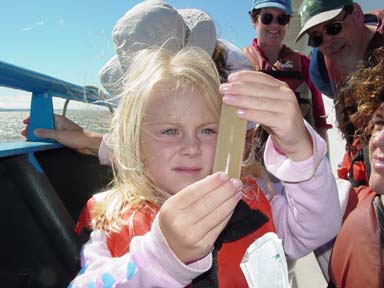
A student from the Marine Science Institute of San Francisco |
Sampling for Water Biodiversity
teacher activity sheet - Global Lab
Bioindicators are living organisms that are present in our environment and can, by their responses to that environment, act as signals of environmental quality.
In this activity, students visit their body of water and sample for several typical bioindicators: microorganisms, aquatic plants, and macro-invertebrates. The samples are then taken back to the lab to be analyzed, identified, and categorized. Students also make careful observations of insects and animals. The data gathered on this trip and in the lab will be used in a class report on biodiversity, and students will return to these data when considering abiotic factors affecting their body of water. |
Materials
small plankton net
plastic zip lock bags
Data Sheets
protective gloves and goggles
temperature probe
jar labels
meter stick
rake or long pole
small, clean, clear high-
density polyethylene (HDPE
dip net
#2 plastic) or glass jars with
study site map
wide mouths and lids
small water pump (optional)
buckets (1 to 5 gallons)
Journals
Water Biodiversity Field Work team assignments
Waterplants Team
Macroinvertebrates Team
Microorganisms Team
|
Activity-at-a-Glance
- Students explore the diversity of organisms in their body of water.
- Students perform several different sampling techniques. |
Classroom Management and Preparation
This activity is done by student teams in the field. The samples collected will be brought back to the classroom for analysis. The plants and other samples should be aerated with a small water pump if possible.
Warning! Although macroinvertebrate sampling can be very interesting and exciting, it can lead to disappointment when done during the wrong season. Macroinvertebrates can usually be found only during warm weather seasons. For northern climates, they typically can be found during the summer and early fall. After this time, the likelihood of finding macroinvertebrates diminishes rapidly. If weather conditions are not favorable for this sample, we suggest that the students focus on the other samples.
You may want to review the protocols before organizing the teams. There is a variety of ways to assign the sampling tasks. One way is to assign the teams to sections of shoreline with varying characteristics (sun/shade, moving/still, human impact areas). Within each team, students could then divide into smaller groups to take the samples. This method allows the students to see a "biodiversity profile" for that section of shoreline. It is important for each group to map clearly where and at what depth the samples are taken.
Either you or several students should prepare a plankton net for use in the field trip. Directions for assembling the net can be found in the Water Biodiversity Field Work: Microorganisms Team instructions.
|
Recommended Procedure
1. Organize the class into teams for the biodiversity field trip. The field trip involves taking three different types of samples at your body of water: microorganisms, aquatic plants, and macroinvertebrates. An additional task will be to record all the sampling locations on a map of the study site.
Time permitting, students can practice the more difficult protocols they will employ in the field trip—for example, using the net or rake to sample the bottom or using open bottles to collect microorganisms. The tasks are described in the Water Biodiversity Field Work team sheets.
2. Have student teams do their fieldwork. To make comparisons and determine the extent of biodiversity in the body of water, the students must follow the protocols provided. Sampling is difficult work, and it may take several attempts before the students are able to gather the organisms they are looking for. If possible, allow them time to take practice samples and return them to the water before taking their final samples.
!Remind students of water safety precautions. These include the use of gloves and goggles whenever they are in contact with the water. Allow them to take samples only in areas that are easily accessible. |
Homework
Have students describe their fieldwork in their Journals.
You can encourage detailed records with questions such as: If you could take the samples again, how might you improve your technique? How well do you think your samples will show the diversity of life in your body of water? |
Extensions
- If your water is a pond or lake, have students look for signs of succession around the body
- preserve the organisms collected in a 70% ethanol solution. |
Assessment
After extensive field work in earlier units, students should now be quite focused and engaged when collecting samples and performing tests. Specifically in this case, they should know to attend to protocols with precision and to record procedures and observations with care. Finally, their teamwork should be more fluid. Any of these activities provides an opportunity for formal assessment. Observationchecklists may be the easiest way to document what you see in the field. You may want to organize a list of behaviors you value with categories such as "achieved" and "still needs work," as well as space fornotes about individual students.
If you use an observation checklist in the field to focus primarily on team accomplishments, students' homework journal entries can help you determine how far individual students have grown in their field skills. |
| Back to Water Index |
